How AI Is Shaping the Future of Autonomous Vehicles

Key Components of AI in Autonomous Vehicles
1. Perception Systems
Autonomous vehicles rely on multiple sensors—LiDAR, radar, cameras, and ultrasonic sensors—to perceive their environment. AI, specifically deep learning, processes this sensor data to identify objects, lane markings, pedestrians, vehicles, traffic signs, and signals in real time.
Technical Approach:
- Convolutional Neural Networks (CNNs): Used for image classification and object detection.
- Sensor Fusion: Combines data from multiple sensors to create a comprehensive environmental model.
Example: Object Detection Pipeline
import cv2
import numpy as np
import tensorflow as tf
# Load pre-trained object detection model
model = tf.saved_model.load('ssd_mobilenet_v2_fpnlite_320x320_coco17_tpu-8/saved_model')
def detect_objects(image):
input_tensor = tf.convert_to_tensor(image)
input_tensor = input_tensor[tf.newaxis, ...]
detections = model(input_tensor)
return detections
2. Localization and Mapping
Accurate localization is essential for safe navigation. AI algorithms process GPS data, inertial measurements, and high-definition maps to determine the vehicle’s precise position.
SLAM (Simultaneous Localization and Mapping):
- Visual SLAM: Uses camera images to map the environment and localize the vehicle.
- LiDAR SLAM: Leverages 3D point clouds for robust localization, especially in poor lighting or adverse weather.
Comparison Table: Visual SLAM vs. LiDAR SLAM
| Feature | Visual SLAM | LiDAR SLAM |
|---|---|---|
| Sensors | Cameras | LiDAR |
| Accuracy | Moderate | High |
| Performance in Dark | Poor | Excellent |
| Data Size | Small | Large |
| Cost | Low | High |
3. Path Planning and Decision Making
AI enables vehicles to plan safe, efficient paths and make complex driving decisions.
Key Algorithms:
- Reinforcement Learning (RL): Trains agents to make sequential decisions (e.g., overtaking, merging).
- Model Predictive Control (MPC): Uses models to predict future vehicle states and optimize control inputs.
Practical Example: Lane Change Decision
# Pseudocode for RL-based lane change
state = get_current_state()
action = rl_policy.predict(state)
if action == 'change_lane_left':
execute_lane_change('left')
elif action == 'change_lane_right':
execute_lane_change('right')
else:
maintain_lane()
4. Edge Computing for Real-Time AI
Autonomous vehicles require low-latency processing. Edge AI hardware (e.g., NVIDIA DRIVE, Tesla FSD chip) processes sensor data onboard, reducing dependency on cloud infrastructure.
Key Considerations:
- Latency: AI models optimized for real-time inference (e.g., TensorRT, ONNX Runtime).
- Power Efficiency: Automotive-grade chips designed for low energy consumption.
Summary Table: Popular Edge AI Hardware for AVs
| Hardware Platform | Compute Power | Supported Frameworks | Vehicles Using It |
|---|---|---|---|
| NVIDIA DRIVE AGX | 320 TOPS | TensorFlow, PyTorch | Volvo, Mercedes-Benz |
| Tesla FSD Chip | 144 TOPS | Proprietary | Tesla Model 3, Y, S, X |
| Qualcomm Snapdragon | 30 TOPS | TensorFlow, Caffe | GM, Honda |
5. Connectivity and V2X Communication
AI processes data from Vehicle-to-Everything (V2X) networks to anticipate hazards, optimize routes, and coordinate with traffic infrastructure.
Applications:
- Predictive Routing: AI uses real-time traffic data for optimal navigation.
- Cooperative Maneuvering: Vehicles communicate intentions for smoother merges and intersections.
6. Continuous Learning and Data Management
Autonomous vehicles generate vast amounts of data. AI systems are updated using fleet learning—collecting edge cases and retraining models for improved performance.
Step-by-Step: Updating AI Models via Fleet Learning
- Data Collection: Vehicles upload edge cases (e.g., near-misses, rare events) to the cloud.
- Annotation: Human annotators label data if necessary.
- Model Retraining: AI models are retrained with new data.
- Validation: Models are tested in simulation and real-world scenarios.
- Deployment: Validated models are rolled out via over-the-air (OTA) updates.
7. Safety, Redundancy, and Regulatory Compliance
AI enhances safety by enabling redundancy and failover systems (e.g., emergency braking, fallback driving modes). Regulatory bodies require explainability and validation of AI models.
Key Practices:
- Formal Verification: Ensures AI decisions satisfy safety constraints.
- Explainable AI (XAI): Techniques like SHAP, LIME provide model transparency.
Summary Table: AI Safety Techniques in AVs
| Technique | Purpose | Example Use Case |
|---|---|---|
| Formal Verification | Guarantee safety properties | Emergency stop |
| Redundant Perception | Backup sensor fusion | Fault-tolerant object detection |
| Explainable AI | Model transparency | Regulatory reporting |
8. Real-World Deployments and Case Studies
- Waymo: Uses deep neural networks for perception and planning; fleet learning enhances performance in diverse environments.
- Tesla Autopilot: Leverages vision-based AI, massive data collection, and continuous OTA updates.
- Cruise: Integrates LiDAR, radar, and cameras with AI for urban navigation.
Actionable Insights for Practitioners
- Invest in robust data pipelines for fleet learning and simulation.
- Prioritize sensor fusion to handle diverse environments and edge cases.
- Optimize AI models for edge hardware to meet real-time constraints.
- Implement redundancy and validation systems for safety and compliance.
- Use explainable AI frameworks to address regulatory and public trust concerns.





0 thoughts on “How AI Is Shaping the Future of Autonomous Vehicles”